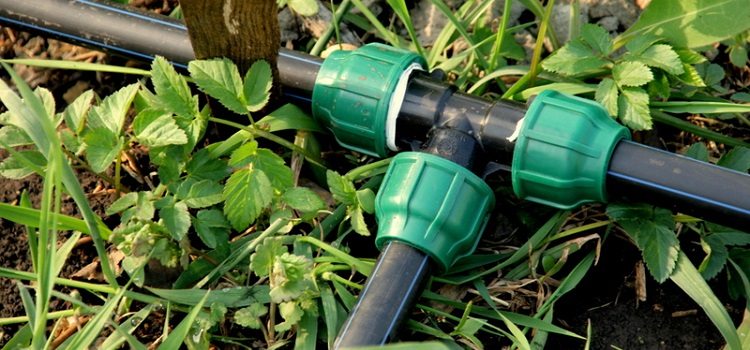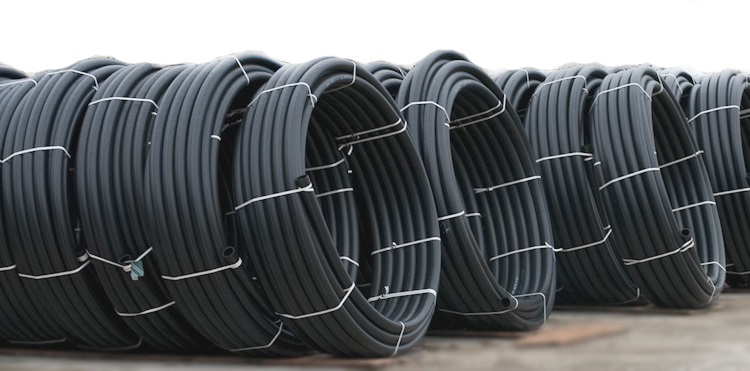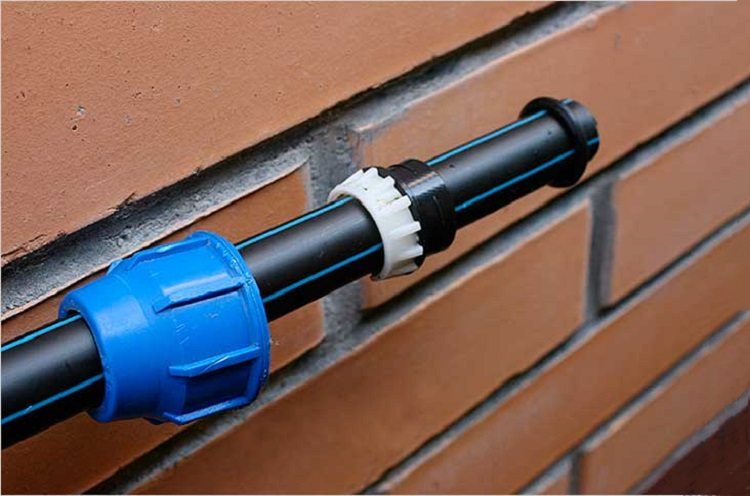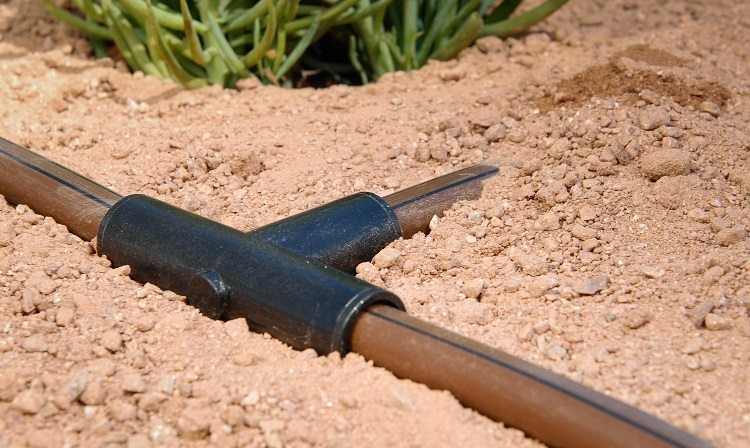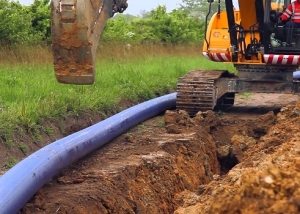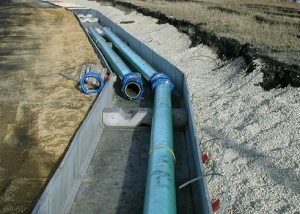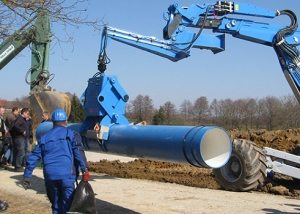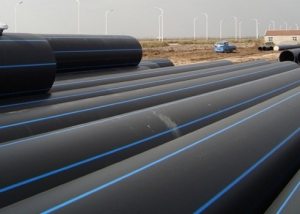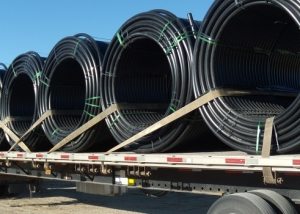Polyethylene multilayer pipes (HDPE) is a complex structure created by the polymerization of ethylene without the use of high pressure. Due to their multilayer structure, these pipes are quite durable and at the same time plastic. Low cost, variety of species and unpretentiousness make it possible use HDPE pipe for water supply in the country, installation of which is easy to implement with your own hands.
Content
HDPE pipe structure
Products from low-pressure polyethylene consist of several layers:
- the inner layer of the pipe is the so-called “cross-linked” polyethylene. The tube-like structure is formed by stitching the edges of the workpiece with a high-temperature method;
- the adhesive layer provides reinforcement of the PND pipe, this allows you to withstand the water pressure, quite sufficient for the implementation of the water supply system in the country;
- the oxygen barrier between the adhesive layers of the HDPE pipe provides resistance to the penetration of oxygen molecules in the water into the structure of the country water supply. Polyethylene pipes without a protective barrier are short-lived, and two adhesive layers provide mechanical strength sufficient for the implementation of an open water supply system;
- the outer polyethylene layer performs protective functions and bears the marking of the manufacturer. Alphabetic indexes indicate the type of pipe, and the option of stitching polyethylene layers.
The country water supply system is an extensive system of supplying cold water from a source to consumers. Cold water is used to irrigate the beds in the country, or to supply water to the collector - the storage of the summer shower. The most commonly used type of PND pipes for water supply to the summer cottage system are PE 80 pipes and PE 100 pipes. The temperature range of this type of pipe is from + 15C to + 40C. Exceeding the maximum threshold for operating temperature will lead to rupture of the water supply system.
In the case of a system with high temperatures and pressure levels up to 10 bar — for example, in “warm floor” systems — pipes with the PE-C marking are used (they are also PE-X in the standards of the international pipe classification).
Chemical and electronic methods for crosslinking polyethylene
Various options for "stitching" layers of polyethylene provide their operational characteristics. Initially, manufacturers used the “nitrogen” crosslinking method during the manufacturing process, due to its low cost. The low strength of the polyethylene layer obtained in this way determined the irrationality of the technology.
The addition of peroxides to the heated polyethylene at the stage of “stitching” the pipe layer during its manufacture makes it possible to create a sufficiently strong structure. The method is common to create pipes used in low pressure water supply systems for supplying cold water.
Crosslinking at the molecular level with a quality of interpenetration of at least 65% is ensured chemically. A mixture of catalysts and silane is added to the polyethylene layer, in this way PE-C pipes are made.
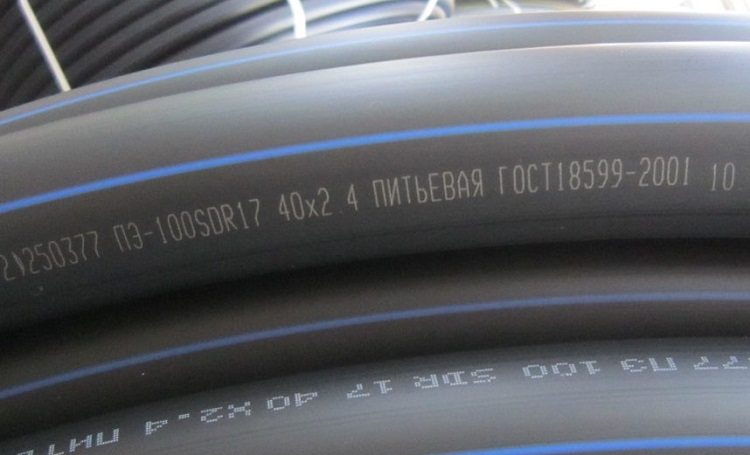
On the outer surface of the pipe is marked, containing data on the purpose and technical characteristics of the product
The "bombardment" of electrons in the polyethylene layer allows the molecules to be stitched into a three-dimensional network with almost 100% interpenetration. The method is the most effective and quite complex, and therefore expensive. This is the best option for a polyethylene pipe for water supply. Do-it-yourself installation of such products can be made as easily as other types of plastic pipes.
Important! International indexes indicating the option of stitching are indicated in capital letters in the index: RE-Xa or RE-Xb. For a country water supply, assembled by yourself, it is quite enough to use a low pressure pipe. In the case of pipes that can withstand high temperatures, the cost of the project increases significantly.
Installation of HDPE pipes for water supply yourself
As a temporary water supply system in the country, pipe installation in an open way is used. The cold water supply circuit is connected using long fittings. Do-it-yourself assembly is characterized by minimal pipe preparation, high reliability and a short period of time for which installation can be realized.
The advantages of the "outdoor installation" method is that HDPE water supply is easy to dismantle during the off-season period. This ensures the safety of the pipe in the cold season, and minimizes the risk of pipe theft from the site during the absence of the owners in the country.
The disadvantage of the method, due to the fact that installation is carried out without an additional protective system, is that there remains the risk of accidental damage to the pipe by garden equipment.
The main supply line is most often implemented using HDPE pipes with a diameter of 40 mm, and bypass pipes with a pipe with a diameter of 20-25 mm. Pipe splicing is performed using compression fittings, such connections remain airtight after several cycles of installation and dismantling.
An open method involves mounting in a country house directly on the soil surface, or, more preferably, on special stand holders. As supporting elements for pipes, fencing elements or summer cottages can be used.
The most important criterion explaining why the HDPE pipe is used for water supply in the country: even a novice installation engineer can install the system. With exact compliance with the plans for laying communications and at minimal cost, you can easily assemble a reliable water supply yourself.
Laying communications in a trench
It is not difficult to secure the country water supply system from mechanical damage if you use the method of laying HDPE pipes in a trench way.
The easiest option: laying pipes in a shallow trench. Further, the pipe is filled with earth, and this ensures its safety and minimizes the effect of ultraviolet radiation from sunlight. The water pipe laid in a trench way is easy to dismantle if necessary. Of course, hiring crews to dig trenches is an additional financial cost. The only way to save the funds allocated for the installation of a water supply system from pipes is to do everything yourself, including land, with your own hands.
A more priority method is the installation of a water pipe in a country house in specially prepared trenches, supplemented with drainage trays and technological covers. The tray protects the pipe from deformation and damage, and works as a simple drainage system. Covers with ventilation holes will not allow condensation to form on the surface of the pipes.
Trench supplemented heating cable throughout the outer part of the water supply system, it will be possible to efficiently use polyethylene cross-linked pipes even at negative temperatures, for example, in winter. In this case, the bills for energy supply will increase, the heating cable is connected in the same way as the pump group to the mains.
Important! For ease of operation, it is customary to equip with shutoff valves - valves - drainage units. A properly laid water supply system for a summer residence, assembled by oneself, has a bias towards the end consumer, and is supplemented by a drain valve that drains the water from the system before dismantling, or during the off-season period.
The process of installing HDPE pipes, tools and fittings
Immediately before the start of installation work, the length of the future water supply in the country is measured. The number of pipes with a diameter of 40 mm for the main line, and the length of 20 mm or 25 mm pipes for branch communications are determined.
For high-quality installation you will need a set of simple tools:
- pipe trimming tool. In this case, a regular hacksaw for metal is useful;
- for processing the ends of the pipe using a short cone-shaped knife;
- fittings are clamped, usually by hand. For craftsmen who prefer to use an adjustable wrench, when tightening the connections, the force should be accurately dosed: overly tight fittings connections - clamping nuts - may burst or the gasket may become deformed. Insufficiently tightened nuts will not ensure the tightness of the connection.
Set fittingsthat are used for installation:
- couplings, they ensure the tightness of the joints of water pipes of the same diameter;
- adapter sleeve allows you to connect water pipes of different diameters to connect the circuit to the main line;
- a coupling in the form of a tee provides an easy way to divert part of the fluid from the main line;
- threaded coupling allows you to combine HDPE pipes with an existing water supply system based on threaded connections;
- a flange connection is used to connect to a water discharge manifold;
- coupling - “saddle” is used for quick connection to the main line of pipe of smaller diameter;
- coupling - plug will ensure the tightness of the end of the pipeline, use the plug when disconnecting any part of the water supply circuit.
The main feature of laying a water pipe based on HDPE pipes with your own hands in the country is that the pipe will not be able to bend at right angles. There is a so-called "turning radius", which will have a value greater than the outer diameter of the pipe. This factor is taken into account when connected to a water supply source. A special transition fitting is used, and the HDPE pipe is smoothly displayed to the depth of the system.
